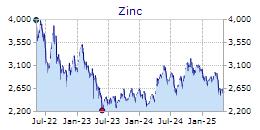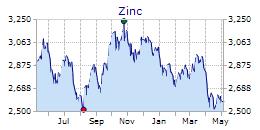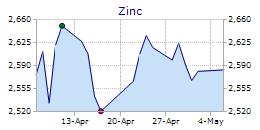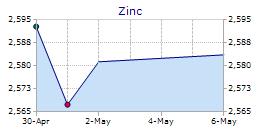|
|
|
#1 |
|
Gründungsmitglied
Registriert seit: Sep 2000
Ort: Bayern
Beiträge: 82.687
|
Zink - Weiteres Potential!
09:25 17.08.06 Zink wird heute zum größten Teil in der Stahlproduktion benötigt. Dieser Rohstoff ist unerlässlich für die Galvanisierung, also die Herstellung von verzinktem Stahl. Seit Ende des letzten Jahres hat der Zinkmarkt eine außerordentliche Entwicklung hinter sich gebracht. Der Preis für eine Tonne Zink betrug im November 2005 noch 1500 USD. Im August 2006 befand sich der Preis für diesen Rohstoff bei fast 3500 USD. Diese Aufwärtsentwicklung ist vor allem auf die starke Nachfrage aus Asien zurückzuführen. Die Nachfrage wird in Indien 2006 um 9,1% wachsen. In China wird es eine Bedarfserhöhung um 7,3 % geben. Der weltweite Verbrauch wird in diesem Jahr um 4,8% auf 11,19 Mio. t steigen, während das Angebot lediglich um 4,5% auf 10,42 Mio. t ausgebaut werden kann. Das erhebliche Angebotsdefizit soll durch bestimmte Regierungsmaßnahmen, z.B. in China, beseitigt werden. Es sind Projekte für eine Kapazitätserhöhung um ca. 765.000 t jährlich in Planung. Diese Maßnahmen werden aber erst in ein oder zwei Jahren Einfluss auf den Markt haben. Im Gegensatz zu den Zinkhütten haben die Zinkminen ihre Produktionskapazität kaum gesteigert. Dadurch wird eine fortschreitende Verknappung der Zinkvorräte erwartet. Die Fundamentaldaten und das Aufholpotential gegenüber anderen Rohstoffmärkten rechtfertigen einen Einstieg. Der stabile Aufwärtstrend könnte Zink in 12 Monaten auf Kurse über 2 USD je Pfund (ca. 4400 USD je Tonne) führen! "berlinvestor Quelle: stock-world
__________________
Schöne Grüße OMI |
|
|

|
|
|
#2 |
|
TBB Family
Registriert seit: Mar 2004
Beiträge: 10.373
|
Interesant ist, das die Industriemetalle dem Chartverlauf von Gold NICHT folgen; guckst Du hier: http://www.traderboersenboard.de/for...threadid=10383
Paradebeispiel ist hier Zink mit einer schönen SKS-Formation, die nun wirklich jeder Marktteilnehmer sehen kann, siehe hier ein Open End Zertifikat auf Zink: Hier ein netter Zink-Short dazu: http://www.abn-zertifikate.de/DE/Sho...N=NL0006021115 Ein schon länger existierender Short: WKN: AA0BHY, Hebel 1,15 Blau: Open End Zertifikat NL0000307874.C52 Man sieht, dass ein Long stärkeren Zeitwertverlust gezeigt hat als der Short. Geändert von Benjamin (09-10-2007 um 23:04 Uhr) |
|
|

|
|
|
#3 |
|
TBB Family
Registriert seit: Mar 2004
Beiträge: 10.373
|
Zink-Charts: http://www.goldseiten.de/content/kurse/metalle_zink.php
Zink Kassa spezial-hochgrädig (EUR/100 kg) London Linear: Logarithmisch: Future-Übersicht London: http://futuresource.quote.com/market...?id=metal&s=LZ Zink-Future (Zinc, SHG, $/mt (lme))     Größere Charts: http://commodities.thefinancials.com/ Dez.-07-Future von Zink: Geändert von Benjamin (15-02-2013 um 22:14 Uhr) |
|
|

|
|
|
#4 |
|
TBB Family
Registriert seit: Mar 2004
Beiträge: 10.373
|

Geändert von Benjamin (15-02-2013 um 22:14 Uhr) |
|
|

|
|
|
#5 |
|
TBB Family
Registriert seit: Mar 2004
Beiträge: 10.373
|
Charts von der LME: http://www.lme.co.uk/zinc_graphs.asp
Geändert von Benjamin (15-02-2013 um 22:14 Uhr) |
|
|

|
|
|
#6 |
|
TBB Family
Registriert seit: Mar 2004
Beiträge: 10.373
|
Zink-Short : NL0006021115.C52, WKN: AA0L9R
Knock Out 3286 Spread 3,69%, 0,30€ Future Dez. 07 http://futuresource.quote.com/charts...IGH&b=LINE&st= 2,62 Hebel http://www.abn-zertifikate.de/DE/Sho...N=NL0006021115 Zink Put NL0000854156 / AA0HTC Emissionstag: 16.05.07 Fälligkeit 02.12.08 Mitte: Anfang Febr. 08 Spread 8,37%, 0,20€ Blau der Short von oben : Geändert von Benjamin (02-10-2007 um 12:00 Uhr) |
|
|

|
|
|
#7 |
|
TBB Family
Registriert seit: Mar 2004
Beiträge: 10.373
|
Datum 05.09.2007 - Uhrzeit 14:46 (©GodmodeTrader)
ZINK Kurstand: 2.943 $ Kursverlauf vom 02.01.2004 bis 04.09.2007 (log. Kerzenchartdarstellung / 1 Kerze = 1 Tag) Kurz-Kommentierung: Zink konnte in den vergangenen Jahren sehr stark ansteigen. Bereits seit Anfang 2006 kommt es aber zu einer Top-Bildung. Eine SKS-Trendwendeformation wurde gebildet die Zink aktuell nach unten auflöst . Maßgebend ist dabei der Bruch der bei 3.200 $ liegenden Triggerlinie . Nachdem Zink in der vergangenen Woche an diese Triggerlinie zurück gelaufen ist und klar nach unten dreht sind jetzt weiter nachgebende Notierungen wahrscheinlich. Die bei 2391 Punkten liegende Unterstützung kann dabei erreicht werden, hier bleibt eine Stabilisierung abzuwarten. Godmode hatte aus Versehen einen NASDAQ 100-Chart eingestellt, siehe http://www.godmode-trader.de/front/?...idc=&id=133982 Hier deren Zink-Chart von einer früheren Analyse: 
Geändert von Benjamin (07-09-2007 um 17:23 Uhr) |
|
|

|
|
|
#8 |
|
TBB Family
Registriert seit: Mar 2004
Beiträge: 10.373
|
Dez.07-Future von Zink: http://futuresource.quote.com/charts...IGH&b=LINE&st=
Geändert von Benjamin (15-02-2013 um 22:14 Uhr) |
|
|

|
|
|
#9 |
|
TBB Family
Registriert seit: Mar 2004
Beiträge: 10.373
|
News:
http://www.finanznachrichten.de/such...s=Zink+OR+Zinc http://www.basemetals.com/ http://www.rohstoffe-go.de/index.php?id=725 Nickel, copper, zinc prices drop amid economic growth concerns; oil prices rise Wed Sep 5, By Lauren Villagran NEW YORK (AP) - The industrial metals market sagged for a third straight session Wednesday as investors weighed large builds in aluminum and zinc inventories against continued unease about the pace of global economic growth. Demand for industrial metals depends on a strong global economy, including sturdy manufacturing and construction industries. Although many analysts now forecast a rate cut - which would stimulate business activity - UBS analysts point out in a report that the "Fed would need to see clear evidence of weakness in the real economy, especially consumption and employment indicators, to weaken decisively before steering towards easing." Copper prices slipped in London and New York markets, while the price of zinc and nickel, metals used to coat steel, also declined. On the London Metal Exchange, nickel shed 4.9 per cent and zinc dropped 3.7 per cent. December copper fell 4.3 cents to US$3.263 a pound on the New York Mercantile Exchange. MOVING TO SURPLUS Short and medium term decline in zinc price projected A timely reminder that base metal prices can fall as well as rise was the theme of the opening presentation at a London one-day zinc-focused event. Author: Lawrence Williams Posted: Wednesday , 05 Sep 2007 LONDON - Speaking at Mining Journal's 20:20 Zinc Day yesterday, zinc market expert Claire Hassall of CHR Metals opened proceedings with a note of gloom for those companies presenting their zinc projects to the assembled audience of mining investors analysts and corporate representatives. CHR Metals is a provider of internet-based analysis of the lead and zinc markets. Prior to setting up the company in 2000, Ms Hassall was Director of Metals Services of specialist metals consultancy Brook Hunt, so has a strong track record in the sector. The zinc price has had a tremendous run over the past year and a half which, as Ms Hassall pointed out, was partly through several years of under-investment in the sector when the prices had remained perilously low, and that no-one at that time had predicted the mercurial growth in first the Chinese and then the Indian economies and consequent demand. China had been an exporter of zinc, but rapidly turned around to become a major importer. Effectively these growing economies are projected, according to Hassall, to add 4 million tons a year to zinc demand between 2000 and 2010 - and looking further ahead a further 4.1 million tons between 2010 and 2020. Although Chinese growth is still running at high levels - 11 percent this year (lower than 2006), overall global demand increase has slowed to around 4-4.5 percent as against 7.4 percent in 2006. But, although demand growth continues at a reasonable, but lower, level, supplies have also picked up sharply over the past year. Hassall pointed out that as zinc mines tend to be far smaller than, say, copper operations, the capital cost of bringing a new mine on stream, or resurrecting an old one, is comparatively low and the mining sector can react much faster as prices rise. She did point out though that there are few, if any, really major new zinc mines on the horizon, but that the continuing surge of new production from smaller operations is sufficient to put the market into surplus up until around 2010. There is also a worry about substitution . As prices rise, consumers may look harder at alternative products and this can have a damaging effect on long term prospects for the metal. So where will the zinc price go? Hassall's research suggested that there may be the occasional upward bumps in price, but that the current downturn being experienced by the sector will continue for the next three years at least, although she feels that some new projects may fall by the wayside if the price does drop, thus easing the downward pressure. The forecast thus is for prices to remain at or around current levels for the remainder of this year, but as much of the new production comes on stream, Hassall expects prices to fall for a number of years thereafter. As far as existing zinc miners are concerned, though, Hassall feels they are mostly very profitable, and can remain so even with a sharp fall. Perhaps this was not what potential investors and zinc miners wanted to hear at a zinc meeting, but after the huge price rises, the reminder that, like other base metals, zinc prices tend to be cyclical in nature is perhaps a much needed return to reality. ######## 04.09.07 Es gibt Spekulationen, nach denen der bestehende Überschuss sich im nächsten Jahr noch verstärken könnte. Viele Minen haben ihre Zinkproduktion angekurbelt,nachdem die Preise auf Rekordhochs geklettert waren. Laut der Londener GFMS Metals Consulting Ltd. socll sich der Überschuss im nächsten Jahr auf 165000 Tonnen ausweiten. www.rohstoffe-go.de , zitiert nach http://www.financial.de/newsroom/derivate/115648.html 22.08.2007 Zinc market swings into surplus in H1 2007 - WBMS LONDON (Thomson Financial) - The zinc market swung into surplus in the first half of the year from a deficit a year before, according to the World Bureau of Metals Statistics. The market recorded a surplus of 85,000 tonnes in the period, against a deficit of 51,000 tonnes in the first half of 2006. Total zinc mine output was 5.163 mln tonnes in the period, up 5.5 pct year-on-year. Refined production rose by 413,000 tonnes to 5.653 mln tonnes with Asian countries, chiefly China, contributing an extra 323,000 tonnes to world output . Meanwhile demand rose 277,000 tonnes, the WBMS said. jan.harvey@thomson.com Geändert von Benjamin (08-09-2007 um 23:53 Uhr) |
|
|

|
|
|
#10 |
|
TBB Family
Registriert seit: Mar 2004
Beiträge: 10.373
|
[B]04.09.2007
Use of cheaper zinc substitutes to shave metal's price in 2008 - analyst LONDON (Thomson Financial) - Increased usage of zinc substitutes will push prices lower next year, while forecasts for higher supply is also likely to put downward pressure on the metal's value, said a leading analyst. Zinc prices are predicted to average 3,400 usd per tonne in 2007 before falling to below 3,000 usd in the longer term because consumers choosing lower priced substitutes will dampen demand, according to Claire Hassall, principal at CHR Metals. Production is also likely to catch up with Chinese and Indian demand, she added. Prices hit a year-low of 2,911 usd earlier today. Speaking at the Mining Journal's 20:20 Investor Series, Zinc Day, this afternoon she said: 'I think very possibly the zinc price is going to come off from here 'Many people believed zinc could stay above 3,000 usd, but this morning has proven us wrong.' Hassall added that although zinc was likely to rise above 3,000 usd again in the short-term, prices will most probably fall next year as consumers continue to source cheaper substitutes. Robust Chinese and Indian demand has fuelled zinc prices in recent years which surprised many miners and squeezed supply. However, with higher prices, many operators invested more into zinc mining which has improved the supply outlook . 'A shortfall in raw material supplies supported prices in 2005 and 2006,' Hassal said. 'Higher prices have kick-started a lot of projects, and a lot of mines have come back into operation.' Zinc is currently trading on the LME at around 2,940 usd. The metal hit a year high of nearly 4,200 usd in May. d.sheppard@thomson.com |
|
|

|
|
|
#11 |
|
TBB Family
Registriert seit: Mar 2004
Beiträge: 10.373
|
Open End Zinc, WKN: ABN0JT
Geändert von Benjamin (15-02-2013 um 22:14 Uhr) |
|
|

|
 |
| Lesezeichen |
|
|
Es ist jetzt 00:09 Uhr.








